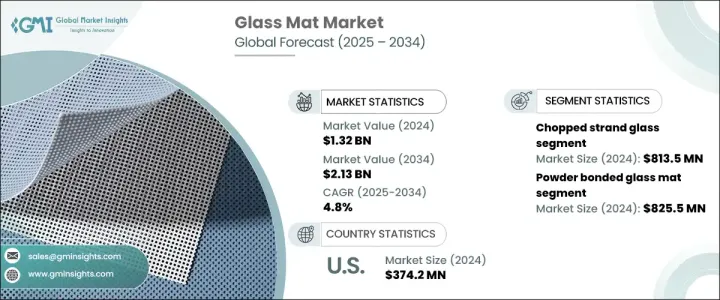
세계의 유리 매트 시장은 2024년에 13억 2,000만 달러의 규모에 이르렀으며, 2025년부터 2034년에 걸쳐 CAGR 4.8%를 나타내 안정된 성장이 전망되고 있습니다.
이 성장은 건설, 자동차, 해양, 전기 등 중요한 산업에서 수요가 증가함에 따라 크게 증가하고 있으며, 이러한 산업에서는 제품의 성능과 효율을 향상시키기 위해 유리 매트의 우수한 특성에 대한 의존도가 높아지고 있습니다. 미세한 유리 섬유로 만들어진 유리 매트는 강도, 내구성, 경량 특성이 높게 평가되어 복합 용도에 이상적인 재료입니다.

산업계가 보다 지속가능하고 고성능인 소재로 변화하는 가운데, 내식성, 우수한 단열성, 에너지 효율이 뛰어난 특성을 가지는 유리 매트는 중요한 기업로서 대두해 왔습니다. 예를 들어 건축 분야에서 유리 매트는 지붕재, 바닥재, 벽면 패널에 사용되며 현대 건축 기준의 진화하는 요구에 부응합니다. 또한 자동차 부문에서는 차량의 경량화와 연비 향상에 중점을 두고 있으며, 유리 매트 수요에 박차를 가하고 있습니다. 특히 에너지 효율적인 건설 및 운송 솔루션에 기여하는 재료를 요구하는 제조업체가 증가함에 따라 환경 지속가능성이 중요하다는 점도 유리 매트 수요를 촉진하고 있습니다.
| 시장 범위 | |
|---|---|
| 시작 연도 | 2024년 |
| 예측 연도 | 2025-2034년 |
| 시작 금액 | 13억 2,000만 달러 |
| 예측 금액 | 21억 3,000만 달러 |
| CAGR | 4.8% |
제품 유형별로는 촙드 스트랜드 유리 매트가 시장에서 압도적인 지위를 차지하고 있으며, 2024년에는 8억 1,350만 달러를 기록해 61.4%의 점유율을 차지했습니다. 이 제품 유형은 범용성과 비용 효율성이 우수하므로 자동차 및 건설 분야에서 사용하기에 특히 적합합니다. 한편, 우수한 강도와 내구성으로 알려진 연속 필라멘트 유리 매트는 특히 항공우주와 풍력에너지 등 고성능 복합재료가 요구되는 산업에서 기세를 늘리고 있습니다. 이 분야는 시장에서 차지하는 비율은 작지만 첨단 복합재료에 대한 수요가 계속 증가하고 있기 때문에 꾸준히 성장하고 있습니다.
바인더의 유형에 관해서는 시장은 주로 파우더 본드와 에멀젼 본드의 유리 매트로 나뉩니다. 2024년 파우더 본드 부문은 8억 2,550만 달러를 창출하여 63.6% 시장 점유율을 확보했습니다. 이 바인더 유형은 비용 효율적이고 적응성이 높기 때문에 다양한 산업에서 널리 사용됩니다. 그러나 우수한 수지 함침과 강화된 기계적 특성을 제공하는 에멀젼 접착 유리 매트는 고급 재료 성능이 필요한 분야에서 인기를 끌고 있습니다. 이 변화는 진화하는 업계 수요에 부응하기 때문에 시장이 더 광범위한 제품군으로 전환하고 있음을 보여줍니다.
북미에서는 미국의 유리 매트 시장이 2024년 3억 7,420만 달러를 창출해 건설 업계와 자동차업계의 강한 존재감을 뒷받침했습니다. 북미의 환경 지속가능성에 대한 노력은 최첨단 제조 기술의 채택과 함께 시장에서의 우위를 더욱 향상시키고 있습니다. 이 지역의 혁신에 초점을 맞추고 엄격한 환경 규제는 유리 매트 수요를 촉진하고 미국이 시장 리더로서의 지위를 굳히는 데 중요한 역할을 하고 있습니다.
The Global Glass Mat Market reached a value of USD 1.32 billion in 2024 and is expected to experience steady growth at a CAGR of 4.8% from 2025 to 2034. This growth is largely driven by rising demand in critical industries such as construction, automotive, marine, and electrical, all of which are increasingly relying on the superior properties of glass mats to improve product performance and efficiency. Glass mats, made from fine glass fibers, are highly valued for their strength, durability, and lightweight characteristics, making them an ideal material for composite applications.

As industries shift toward more sustainable and high-performance materials, glass mats have emerged as a key player due to their corrosion resistance, excellent thermal insulation, and energy-efficient properties. In construction, for example, these mats are utilized in roofing, flooring, and wall panels, meeting the evolving demands of modern building standards. Additionally, the automotive sector's focus on reducing vehicle weight and enhancing fuel efficiency is fueling demand for glass mats. The growing emphasis on environmental sustainability is also driving the demand for glass mats, particularly as manufacturers seek materials that contribute to energy-efficient construction and transportation solutions.
| Market Scope | |
|---|---|
| Start Year | 2024 |
| Forecast Year | 2025-2034 |
| Start Value | $1.32 Billion |
| Forecast Value | $2.13 Billion |
| CAGR | 4.8% |
In terms of product types, chopped strand glass mats hold a dominant position in the market, generating USD 813.5 million in 2024 and accounting for a 61.4% share. This product type's versatility and cost-effectiveness make it particularly appealing for use in the automotive and construction sectors. Meanwhile, continuous filament glass mats, known for their superior strength and durability, are gaining momentum, particularly in industries such as aerospace and wind energy, where high-performance composites are in demand. Although this segment represents a smaller portion of the market, it is steadily growing as the demand for advanced composite materials continues to rise.
When it comes to binder types, the market is divided primarily into powder-bonded and emulsion-bonded glass mats. In 2024, the powder-bonded segment generated USD 825.5 million, securing a 63.6% market share. This binder type is cost-effective and adaptable, making it widely used across various industries. However, emulsion-bonded glass mats, which offer superior resin impregnation and enhanced mechanical properties, are gaining popularity in sectors requiring advanced material performance. This shift signals the market's move toward a broader range of products to cater to evolving industry demands.
In North America, the U.S. glass mat market generated USD 374.2 million in 2024, supported by the strong presence of the construction and automotive industries. North America's commitment to environmental sustainability, along with the adoption of cutting-edge manufacturing technologies, further bolsters its dominance in the market. The region's focus on innovation, coupled with stringent environmental regulations, plays a significant role in driving demand for glass mats and solidifying the U.S.'s position as a market leader.